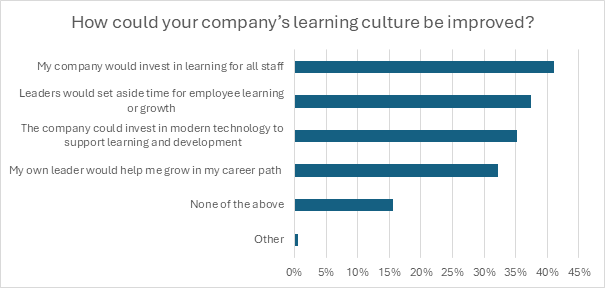Psychology research shows that when we face an overwhelming number of challenges, it’s easy to lose hope and feel helpless. In reality, today’s employees are faced with more challenges than ever before, and while some of the variables are outside employer control, that doesn’t make the situation any less difficult for the workforce.
For example, headlines abound focusing on the business risk of losing high-performing employees, and a recent PwC report indicates that the second wave of the Great Resignation could be just around the corner. Not only that, but for yet another year, and other reputable organizations indicate that employee engagement remains stagnant, costing employers upwards of nine trillion dollars annually in lost productivity.
In addition, burnout rates and mental stress are also a critical problem, and Deloitte reports that three in four workers have felt burnt out in their current job at least once. To cap it off, news and stories about the proliferation of artificial intelligence have made seven out of 10 workers concerned about the long-term viability of their skills.
Perhaps that’s why 70% of workers in our new study said that they were worried about AI disrupting the skills they need to remain viable in the workforce today?
It’s an overwhelming series of challenges for employers as they attempt to support a productive and capable workforce. What options exist to help drive engagement and retention while giving each employee a sense of progress in their skills and work?
In a new research study of 2,000 global learners, the team at Lighthouse Research & Advisory partnered with Adobe to uncover some of the aspirations, needs, and priorities of workers, and one clear opportunity stands out as an option to combat this variety of challenges—a culture of learning based on autonomy and opportunity.
Is a Culture of Learning the Best Solution to Workforce Disengagement and Turnover?
The concept of a “culture of learning” isn’t exactly new, but many companies have struggled to clearly define, enact, and support the type of culture that drives real results for the workforce and the business.
But out of all the potential strategies organizations can pursue, developing a true culture of learning seems to resolve each of the challenges laid out above. For instance:
- Learning availability and uptake links to stronger employee retention and a sense of belonging
- Learning, especially with modern technology, helps employees feel more control over their skill development in a fast-paced, disruptive work environment
- Learning elevates performance and productivity
- Learning based on opportunity and autonomy gives burnt out workers a path forward instead of just spinning their wheels
This is a great solution, but some gaps are holding employers back from success. For instance, nearly half the workforce thinks their learning technology is archaic and in need of modernization. This is especially true for Gen Z, which is estimated to make up about one-third of the workforce by 2030. In addition, the most typical reason learners say they learn at work is because it was mandatory or required. In other words: someone made them do it, not because it was voluntary or for career growth. Finally, about half the workforce says their manager isn’t fully supportive of their career development, which creates a sense of stagnation that ultimately leads to higher turnover.
The data points in the research indicate a path forward, though. Within the following pages, we’ll uncover:
- How employers can create a culture of learning in practical, concrete terms
- The top priorities of learners today and how to meet them
- Key benefits of a culture that meets the needs of learners
It’s time to go beyond words and begin actively connecting learner needs with the culture and values of the organization. This powerful connection drives real and lasting value both for the business as a whole and for each individual person across the workforce.
A Practical Guide to Creating a Culture of Learning
There’s a term in psychology called “expectation violation.” It describes the gap between what we expect in any given situation and what we actually experience. For instance, if you enter an upscale restaurant and expect amazing food and excellent service, but you end up receiving lackluster service and terrible food, that gap between what you expected and received is your degree of expectation violation. It’s almost as if someone lied to you—bottom line: it’s not pleasant.
Organizational culture is the same way. If we expect a culture of X and we get a culture of Y, that can create a sense of expectation violation that’s hard to recover from.
Within any organization, the culture isn’t just what leadership thinks or says it is—it’s what everyone lives out at work. Culture is both a powerful and a fragile thing. Alignment with culture and values can strengthen performance, retention, and other key metrics. But when words and actions don’t align, that can damage culture and the people who are part of it.
For instance, let’s assume that organizational leadership says learning and skill development are critical organizational priorities. However, at the same time, the company is using outdated learning technology, allots no time for learning activities, and offers no support for skill development. It’s fairly obvious at that point what the real priorities are, and learning isn’t one of them.
In a recent interview with Cheryl Gochis, the Chief Human Resources Officer of Baylor University, she offered a piece of wisdom from their internal leadership training that is relevant to this discussion:
“We tell the managers in our classes that employees will talk about them at the dinner table with family and friends. They don’t want to believe it, but it’s true. We also tell them that they have the opportunity to influence those conversations: they can either be negative or positive. That ‘aha’ moment helps to get them committed to learning how to embrace the challenges and joys of leading others.”
Let’s look at that same concept through the lens of a culture of learning. Our employees will talk about our culture one way or the other. But are we investing in and supporting one that shows learning and career growth matter, or are we showing that learning isn’t one of the real priorities for business? Within the research, we gave learners a few different ways to identify the type of learning culture at their organization.
Identifying Existing Learning Cultures

Source: 2024 Corporate Learner Experience Study (n=2,000 workers)
To translate these answers above: organizations approach learning either as corrective (13%), mandatory (50%), or empowering (38%).
Let’s touch on those two words that set apart a high-quality learning culture: autonomy and opportunity. Autonomy is simply having choices and options when it comes to learning, not just a set of prescribed, mandatory courses. Opportunity is more about having the support and time freedom to pursue learning activities.
Mandatory training is a part of life. Employees need harassment training, ethics refreshers, and other similar support on a regular basis. But if that’s the only reason and opportunity they have to learn, they will lose interest in other training. One of the most common questions we hear from learning and HR executives is: “How do we get our people to pursue additional learning opportunities?” The research is clear: 51% of learners said that stronger alignment to their career path would make them interested in additional training, and 42% said autonomy and choice in their learning options would also positively influence pursue of additional learning opportunities.
When prompted, learners had some specific suggestions for how their learning culture could be improved.
Improvements to Learning Culture

Source: 2024 Corporate Learner Experience Study (n=2,000 workers)
Each of these is an important element, but one comment from a survey respondent was telling: “[Our learning culture could be improved by] Carefully planned professional development. Often times our professional development is thrown together at the last minute.”
Learning must be seen as an essential element of work, not a separate part. Just 14% of learners in an empowered learning culture say that people are too busy to learn, but in companies with a corrective learning culture, that number increases nearly 280%. And there’s an unpleasant side effect of working at a company where people are too busy to learn—workers are twice as likely to have plans to quit their jobs.
Let’s look at some of the other aspects of a positive, empowered learning culture and why it is a superior approach.
Comparing Learning Cultures
| Employees are trained when not performing well (Corrective) | Employees have autonomy and opportunity to learn (Empowered) | |
| My organization offers learning to grow my skills and performance. | 56% | 90% |
| My manager is very supportive of my development. | 37% | 73% |
| I am not confident that I am making career progress. | 28% | 4% |
| I have regular, ongoing opportunities for social learning. | 15% | 52% |
| I have full visibility into internal learning opportunities. | 42% | 81% |
| I’m happy in my job with no plans to quit. | 46% | 81% |
Source: 2024 Corporate Learner Experience Study (n=2,000 workers)
In addition to some of the other aspects highlighted above, one other element in a culture of learning is how the tools and technology fit in. Culture can be a bit undefined, but the investments and support a company makes give a very tangible perspective of what is really important.
Instead of thinking about a culture as a loose collection of words, values, or ideas, we have to look at the practical and visible practices and outcomes that define it. The following four questions can be asked to evaluate progress towards the intended learning culture:
- Modern learning technology makes relevant learning easily accessible to the workforce. Is the company investing in modern learning technology? Do all employees have access, or is it reserved for a select portion of the workforce?
- Relevant and valuable content help to engage and upskill learners. Does the company provide access to job-relevant content for its workforce? If so, is the content easy to find and access?
- Regular manager conversations about skills give a jumping-off point for growth and development opportunities. Does the company prioritize manager development conversations with their team members? Are those discussions modeled by leaders across all levels of the organization?
- Employers that seek to understand and meet the needs of a diverse learner population will have more success than those with a one-size-fits-all approach. Does the organization have an awareness of the unique needs of different demographics? If so, does the organization offer multiple modalities or channels so that learners can be developed in their preferred manner?
Perhaps the best advice when it comes to culture is a lesson many of us learned as children. Show, don’t just tell.
If learning is important, show how it is prioritized, don’t just give lip service to the idea. In the following section, we’ll examine some of the key priorities for learners across the workforce today, offering insights into how employers can support and serve each individual and the needs they have.
Want to learn more? Check out the full report.

Ben Eubanks is the Chief Research Officer at Lighthouse Research & Advisory. He is an author, speaker, and researcher with a passion for telling stories and making complex topics easy to understand.
His latest book Talent Scarcity answers the question every business leader has asked in recent years: “Where are all the people, and how do we get them back to work?” It shares practical and strategic recruiting and retention ideas and case studies for every employer.
His first book, Artificial Intelligence for HR, is the world’s most-cited resource on AI applications for hiring, development, and employee experience.
Ben has more than 10 years of experience both as an HR/recruiting executive as well as a researcher on workplace topics. His work is practical, relevant, and valued by practitioners from F100 firms to SMB organizations across the globe.
He has spoken to tens of thousands of HR professionals across the globe and enjoys sharing about technology, talent practices, and more. His speaking credits include the SHRM Annual Conference, Seminarium International, PeopleMatters Dubai and India, and over 100 other notable events.
